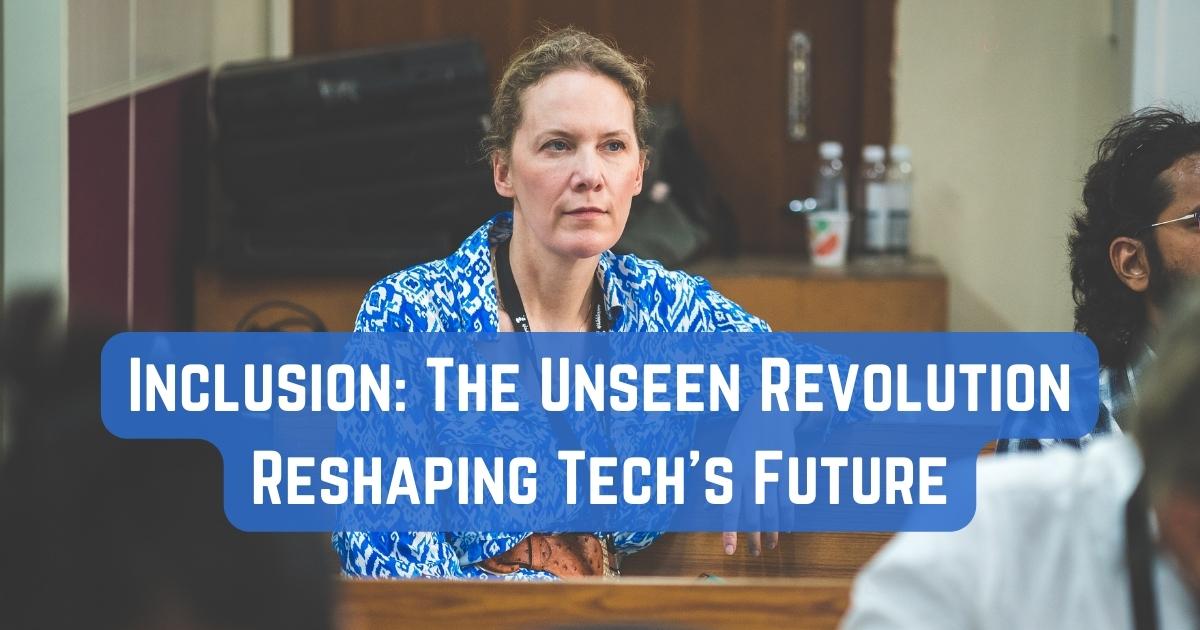
“Once again Saltmarch has knocked it out of the park with interesting speakers, engaging content and challenging ideas. No jetlag fog at all, which counts for how interesting the whole thing was."
Cybersecurity Lead, PwC

As we near the close of 2023, the tech industry finds itself at a pivotal moment, and it's not about the latest gadgets or the evolving landscape of blockchain. The real game-changer? Inclusion and accessibility. That's right, the industry is waking up to the fact that designing for everyone isn't just a moral imperative; it's a largely untapped reservoir of innovation and market potential. From voice recognition technology that's making smart homes smarter to quantum computing that's revolutionizing assistive technologies, the focus is shifting from the 'average user' to a more inclusive and fluid spectrum of human experiences.
In this article, we'll dive deep into why the smartest minds in tech are obsessing over inclusive design and why you should too. We'll explore how the once-overlooked 'edge cases' are becoming the new mainstream, driving a new era of innovation. We'll look at how skills-based hiring is unearthing hidden talent pools, how AI is becoming a tool for empathy, and why the concept of 'normal' is undergoing a radical transformation. We'll also delve into why inclusion is more than just a feel-good mantra; it's the untapped goldmine of tech innovation. So buckle up, because we're about to take you on a journey through the future's secret sauce—Inclusion.
Forget the middle ground; the real action is happening at the fringes. The tech industry is undergoing a paradigm shift, and it's not just about the latest gadgets or blockchain. The real disruptor? Accessibility. That's right, what was once considered the domain of 'edge cases' is now taking center stage, and here's why:
Take voice recognition technology, for example. Initially developed as an 'assistive technology,' it has now become a cornerstone of smart homes and is even making its way into automotive systems. The reason? By focusing on solving complex problems like voice recognition for individuals with speech impairments, the technology naturally evolved to address simpler, more common use-cases, expanding its market reach.
Imagine a world where your devices adapt to you, rather than the other way around. Bio-adaptive technology uses biometric data to automatically adjust device settings. For instance, a screen could adapt its brightness and contrast based on retina scans, offering a personalized user experience that caters to individual needs, including those with visual impairments.
Quantum computing is no longer just a theoretical concept; it's rapidly moving towards practical applications. One surprising area where it could make a significant impact is accessibility. Quantum algorithms can process complex simulations much faster than classical computers, enabling real-time adjustments to assistive technologies like prosthetic limbs or exoskeletons.
Blockchain isn't just for cryptocurrency; it's also a powerful tool for accessibility. Decentralized identity systems allow users to store their personalized accessibility settings securely and share them across devices and platforms. Walk up to any device, authenticate your identity, and voila, the device configures itself to your needs.
As AI becomes more integrated into decision-making processes, there's a growing need for ethical oversight, especially when it comes to accessibility. Ethical AI systems can flag or correct unintentional biases, ensuring that even the edge cases are considered in the decision matrix.
Don't underestimate the power of the community. Open-source platforms for crowdsourcing accessibility solutions can democratize the design process. Users can submit unique problems, and the community can collaboratively develop and vote on solutions, accelerating the pace of innovation.
Therefore, focusing on edge cases isn't just a feel-good endeavor; it's a strategic move. By venturing into the unexplored territories of innovation, the tech industry is not only catering to specific needs but also redefining the boundaries of what technology can achieve. The edge cases are, in fact, becoming the new mainstream.
Forget the paper trail of your career; it's your skills that are now in the spotlight. The hiring landscape is undergoing a seismic shift, thanks to technology. Traditional hiring methods that relied heavily on resumes and formal qualifications are becoming increasingly obsolete. Why? Because they often don't provide a full picture of a candidate's capabilities and can even introduce various biases into the hiring process.
The concept of skills-based hiring isn't new, but technology has supercharged its adoption. Easy-to-use, accessible skills-testing platforms have made it possible to evaluate candidates on their actual abilities rather than their on-paper qualifications. According to a report by TestGorilla, 76% of organizations used skills-based hiring practices in 2022. The benefits are manifold: reduced time-to-hire, lower costs, and a more diverse talent pool.
The surge in technology, accelerated by events like the pandemic and the Great Reshuffle, has led to the development of advanced recruiting tools. These tools can accurately test for more than 300 skills via online assessments, making the hiring process more objective and efficient. The technology also enables remote and hybrid job roles, further expanding the talent pool.
One of the most significant advantages of skills-based hiring is its potential to reduce unconscious bias. Traditional resumes can inadvertently reveal a candidate's gender, race, or age, influencing hiring decisions. Skills-based hiring, on the other hand, focuses solely on a candidate's abilities, making the process more equitable.
Companies that have adopted skills-based hiring have seen tangible benefits. According to TestGorilla's report, 92.5% of organizations saw a reduction in mis-hires, 89.8% saw a reduction in cost-to-hire, and 91.4% saw a reduction in time-to-hire.
As we move forward, the focus is shifting from what you've done to what you can do. Skills-based hiring is not just a trend; it's becoming the standard, driven by technological advancements and a changing work landscape. So, the next time you're job hunting or hiring, remember: it's your skills that count, not just what's on a piece of paper.
AI is no longer just a tool for crunching numbers or automating tasks; it's becoming a catalyst for a more empathetic and inclusive design. The fusion of AI and empathy is transforming the way we interact with technology, making it more personalized, efficient, and accessible. Here's how:
One of the most impactful ways AI enhances user experience is through personalization. By collecting user data and behavior patterns, AI algorithms can tailor the experience to meet individual needs and preferences. This level of customization not only increases user satisfaction but also fosters a sense of connection, as users feel the technology is designed specifically for them. However, designers must tread carefully to ensure that personalization doesn't compromise user privacy or exploit them in any way.
AI's predictive capabilities offer another layer of personalization. Algorithms can anticipate user preferences and behaviors, providing tailored recommendations for products, services, or content. This not only makes the user experience more relevant but also saves time by automating the search for appropriate options. To make these recommendations truly beneficial, designers must incorporate empathy into the AI algorithms, ensuring that users are exposed to new and diverse perspectives, rather than just reinforcing their past behaviors.
Chatbots and other conversational interfaces are another domain where AI has made significant strides. These AI-driven tools can offer quick and efficient customer service, freeing up human resources for more complex tasks. The key to their success lies in designing them with empathy. Chatbots should understand the context of the conversation, respond in a natural, human-like manner, and provide relevant information, ensuring a positive user experience.
AI also has the potential to make technology more accessible to users with disabilities. For instance, natural language processing can provide audio descriptions for images or automatic captioning for videos. The empathetic approach in accessibility design ensures that the needs of users with disabilities are considered at every stage, making technology truly inclusive.
In summary, AI is revolutionizing user experience by making it more personalized, efficient, and accessible. However, to unlock its full potential, designers must approach AI with empathy, considering the diverse needs and interests of users.
The concept of 'normal' is undergoing a radical transformation, especially in the tech industry. The old notion that there's a one-size-fits-all solution for design and user experience is fading fast. Instead, the industry is waking up to the reality that 'normal' is a fluid spectrum that changes over time and varies from person to person.
The traditional approach to design and development often targets the 'average user,' a hypothetical persona based on aggregated data. However, this approach can be limiting and exclusionary, failing to account for the diverse range of human experiences and needs.
What is considered 'normal' can change due to various life events, such as aging, accidents, or health conditions. For instance, someone who didn't require accessibility features may suddenly need them after an accident. This fluidity means that design must be adaptable to cater to a changing spectrum of needs.
The tech industry is increasingly adopting adaptive and responsive design techniques to cater to this fluidity. These designs automatically adjust based on user behavior and preferences, ensuring a more personalized and inclusive experience.
Data analytics and AI play a crucial role in understanding this fluid spectrum. They can analyze large sets of user data to identify patterns and anomalies, helping designers create more inclusive and adaptable solutions. However, it's essential to use this data responsibly to avoid reinforcing stereotypes or biases.
The future of tech design is one that is inclusive by default, not just as an add-on feature. This involves a fundamental shift in mindset, from designing for the 'average user' to designing for a fluid and diverse range of human experiences.
The concept of 'normal' is evolving, and the tech industry must evolve with it. By recognizing that 'normal' is a fluid spectrum, designers and developers can create more inclusive, adaptable, and user-friendly products and services.
Inclusion isn't just a buzzword or a moral imperative; it's a largely untapped reservoir of technological potential. As we move deeper into the digital age, the tech industry is beginning to recognize the immense value of designing for everyone, not just the so-called 'average user.'
Australia, for example, is seizing the opportunity to become a world leader in creating a more equitable and accessible society through technology. The country's Disability Royal Commission has been instrumental in pushing for greater inclusion and accessibility. Organizations like Remarkable, supported by the Cerebral Palsy Alliance, are pioneering this effort. They have incubated 61 startups focused on tech solutions for people with disabilities, securing almost $30 million in investment and serving over 120,000 customers.
The disability sector represents a relatively untapped market with enormous potential. According to Pete Horsley, the founder of Remarkable, technology is becoming increasingly prevalent in every aspect of our lives, and all tech is essentially assistive tech. By focusing on inclusion, businesses can tap into a lucrative consumer base while also driving innovation. Accessibility View's approach, as demonstrated by Scott Davis, offers a compelling business model. The platform's use of open-source solutions like the US Web Design System underscores the economic efficiency and market readiness for accessible technologies, making the case for inclusion not just ethical, but financially sound.
One of the key principles of inclusive technology is co-designing products with a diverse community of people who have experienced disabilities. This approach ensures that the products meet the actual needs of the users, rather than being designed based on assumptions or stereotypes.
As we look ahead, it's clear that inclusion will play a pivotal role in the tech industry. Initiatives like the 'Design-athon' and 'Accelerator' programs, as well as scholarship programs for entrepreneurs with disabilities, are just the beginning. The tech industry has the tools and the talent to make inclusion the norm rather than the exception, and in doing so, it can unlock a goldmine of untapped technological potential. In line with this vision, Scott Davis' keynote at the Great International Developer Summit (GIDS) 2024, scheduled for April 26, will be a significant event to watch. Davis will share insights from his latest venture, Accessibility View, and discuss how digital modernization through accessibility is reshaping the tech industry's future. His talk is expected to highlight the importance of inclusive design and how it can lead to innovative breakthroughs that benefit everyone.
Have questions or comments about this article? Reach out to us here.
Banner Image Credits: Attendee at Great International Developer Summit

“Once again Saltmarch has knocked it out of the park with interesting speakers, engaging content and challenging ideas. No jetlag fog at all, which counts for how interesting the whole thing was."
Cybersecurity Lead, PwC

“Very much looking forward to next year. I will be keeping my eye out for the date so I can make sure I lock it in my calendar."
Software Engineering Specialist, Intuit

“Best conference I have ever been to with lots of insights and information on next generation technologies and those that are the need of the hour."
Software Architect, GroupOn

“Happy to meet everyone who came from near and far. Glad to know you've discovered some great lessons here, and glad you joined us for all the discoveries great and small."
Web Architect & Principal Engineer, Scott Davis

“Wonderful set of conferences, well organized, fantastic speakers, and an amazingly interactive set of audience. Thanks for having me at the events!"
Founder of Agile Developer Inc., Dr. Venkat Subramaniam

“What a buzz! The events have been instrumental in bringing the whole software community together. There has been something for everyone from developers to architects to business to vendors. Thanks everyone!"
Voltaire Yap, Global Events Manager, Oracle Corp.